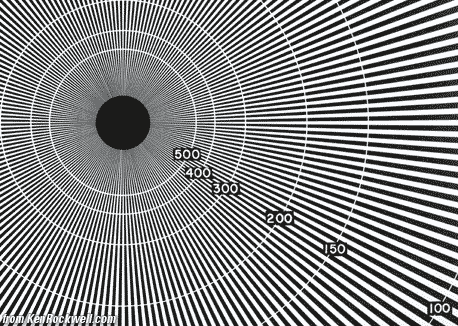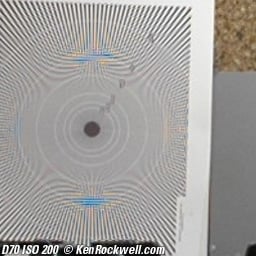Home Search Gallery How-To Books Links Workshops About Contact
|
A Radial Resolution, or "Star," Target I
get my goodies at Ritz, Amazon and Adorama. INTRODUCTION Old-fashioned film-camera resolution targets, like the popular USAF targets, used pairs of lines at successively smaller spacing. These old targets worked fine for film, because 1.) film doesn't care in what direction the lines go, and 2.) film doesn't do anything abruptly weird as the line spacing gets bigger or smaller. These old resolution targets aren't much use for digital cameras, but sadly people still use them. Even the "digital camera targets" some people use are based on the old film targets, since the hobbyists who created those targets are coming from the old film paradigm. These old targets don't tell us very much with digital cameras because most fail to test at every resolution (not just steps) and they all fail to test at every possible angle. Digital cameras use pixels arranged as squares. Others, like Fuji, use octagons. Television uses non-square pixels (720 x 483 at 4:3 in ITU-R BT.601). Resolution, and artifacts, vary wildly with orientation. We need a target which excites every frequency and angle without gaps. Cameras with aliasing issues, like my Nikon D70, usually test OK with film-heritage and "digital camera test" targets. This is because weird artifacts will be at their worst at only some angles and resolutions (spatial frequencies). Most conventional targets miss these issues.
D70 Aliasing See those weird blue regions? That's how easy this target makes it to see the D70's aliasing problem. This almost never affects my photography, and this target makes it easy to see. I only whipped out this target yesterday and saw how obvious this is. Note how it only happens in very small areas of the target - areas which simply aren't on conventional resolution targets. INTRODUCING THE STAR TARGET And let me introduce myself: I've been making my living in broadcast and TV engineering since the 1970s. I learned the word "pixel" in 1973. I stopped to get a degree in electrical engineering, and then continued on to make my living in digital imaging full time since the 1980s, including designing the hardware and resampling algorithms that make our digital cameras work, at places like TRW, who invented the world's first integrated digital-to-analog converter fast enough to work in video and digital cameras, and at Tektronix, who are the world's standard for measuring electronic images. At TRW I helped everyone from the NSA to NASA to the BBC design digital imaging gear, and at Tektronix I spent a decade as Hollywood's go-to-guy for the last word in how to measure images. I left all this to work on this website for you guys in 2004. This vast experience is why digital camera stuff is childs' play for me: I've been studying it since I was 11 years old! Something we take for granted in electronic imaging is the radial resolution, or "star," target. Ideally this target shows lines heading smoothly towards the center, and turning gray (not darker or lighter) when they get so close that they no longer are resolved. The Moiré issues you may see in my scan at the top are artifacts of Photoshop's resampling algorithms. If any of you mathematicians out there know of a Photoshop plugin which does a better job of resampling for technical things like this I'd love to hear about it. To be honest, star targets are simpler targets with fewer lines used for setting focus and back focus of zoom lenses in TV and motion picture work. I'm too lazy to type "radial resolution target" too many times. These targets test every resolution continuously, and in every possible direction. They have no steps or jumps. The star target lacks the broad range of the USAF targets, which can measure resolutions from 1/4 lpmm to 250 lpmm on the same target. The USAF target only measures in two directions and only in 12% steps. We don't care: In digital imaging the weird stuff only happens in more narrow ranges of spatial frequencies. Problems like aliasing, sampling, resampling and other digital artifacts easily and often fall into the gaps not tested (or excited) by the USAF target and those used by the less seasoned in digital media. The easiest way to kill a digital system is to try a radial resolution target. In an instant you'll see any aliasing, moiré, cross color and loads of other weird artifacts. That's why you people made me dust them off and start using them in the near future for my camera comparisons. VARYING AMPLITUDES For testing noise reduction it would be helpful to have star targets which also vary in amplitude. NR algorithms don't touch sharp edges, which have high amplitude detail. NR smudges low-amplitude details and flat areas. Even more devious and helpful than the 100% amplitude target I have, would be a star target with targets of varying contrasts. This would let us see what NR algorithms do with varying degrees of detail. THE SINUSOIDAL ZONE PLATE For electronic-only (not camera) testing we also have a devious pattern called the Sinusoidal Zone Plate. It is a radial resolution target, turned inside-out in the spatial domain. I've never seen anyone use this for still-image analysis. We use it in motion imaging, and we animate it so it wiggles like a puddle does when a raindrop hits it. Like the star target, it almost instantly breaks any weakness in coding systems because it excites all frequencies in all directions. RECOMMENDATIONS Don't worry about this. I wrote this article to explain why I use star targets for testing digital cameras while most people who come from other (film) backgrounds use the wrong targets and miss things. I'll be able to show you camera problems you'll almost never see in real photography, and this way you'll know what they are and how to avoid them. Sorry if I got a little too close to the engineering domain, but that's the only domain in which this makes complete sense. Unless you are comfortable with abstract engineering mathematical transforms among time, frequency and space, all in several axes at once, this will never make complete sense. This is why the mainstream media never fully clarifies technnical things to the general public: writers don't have the engineeing degress required to understand this deeply enough to make it clear. I could, but I'm too lazy! PLUG If you find this as helpful as a book you might have had to buy or a workshop you may have had to take, feel free to help me write more with a donation. Thanks for reading! Ken |
Home Search Gallery How-To Books Links Workshops About Contact





